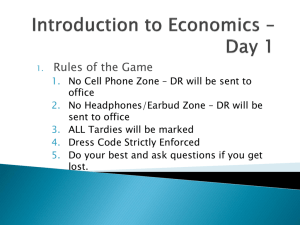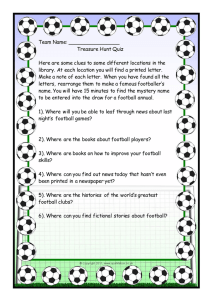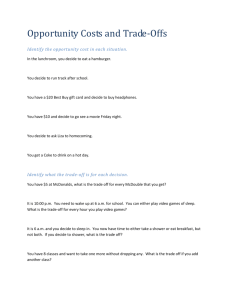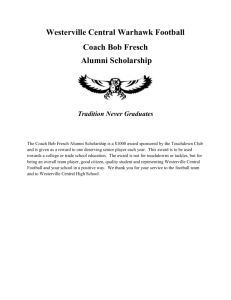Football Economics - SchoolhouseTeachers.com
advertisement
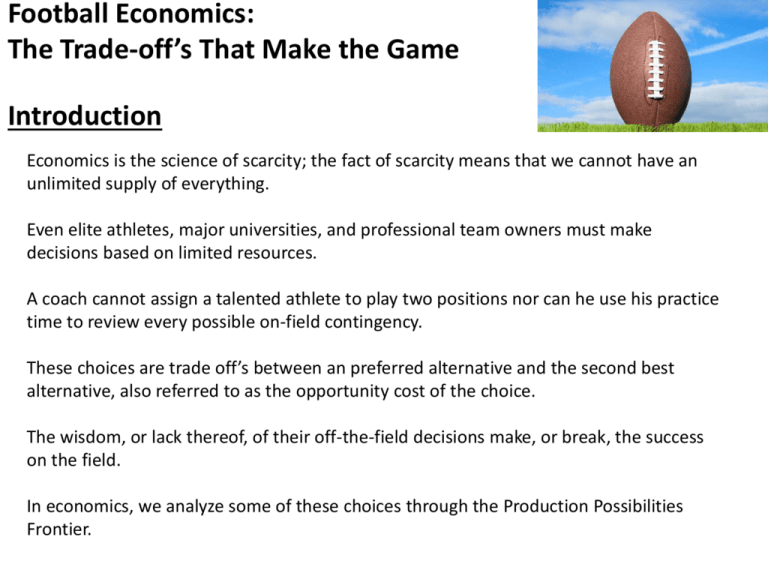
Football Economics: The Trade-off’s That Make the Game Introduction Economics is the science of scarcity; the fact of scarcity means that we cannot have an unlimited supply of everything. Even elite athletes, major universities, and professional team owners must make decisions based on limited resources. A coach cannot assign a talented athlete to play two positions nor can he use his practice time to review every possible on-field contingency. These choices are trade off’s between an preferred alternative and the second best alternative, also referred to as the opportunity cost of the choice. The wisdom, or lack thereof, of their off-the-field decisions make, or break, the success on the field. In economics, we analyze some of these choices through the Production Possibilities Frontier. Football Economics: The Trade-off’s That Make the Game College Football: The Producers The Athlete • Grades • Positive Image for the School • Success for the team • Positive impressions for the pro-scout • Entertainment for the fans. The Coach • Wins • Positive image for the school • Graduating players The Administration • A winning football program • Superior academics • Other winning sports programs Football Economics: The Trade-off’s That Make the Game Professional Football: The Producers The Athlete The Coach • Positive image for the team • Success for the team • Side endorsement deals • Entertainment for the fans. • Wins • Positive image for the team The Owner • Profits in football • Profits in other businesses Football Economics: The Trade-off’s That Make the Game The Production Possibilities Frontier (PPF) The Production Possibilities Frontier is an analytical framework that helps us visualize and calculate trade-off between different things a person, a business, or a society might produce. The classic example comes from the Bible, “They will beat their swords into plowshares and their spears into pruning hooks.” The verse refers to peace under the Messiah. In the economics example, a society has a scarcity of the metals needed for both products and must, literally, trade one for another. Thus, the opportunity cost of one pruning hook might be the one two spears that have to be melted down and reshaped to form it. This concept works with any two items that share a common link in the production process. For example, Selena Gomez may be able to make either two films or two albums in one year but he cannot make both. She lacks the time necessary to create all four. On the other hand, she might have the options to make two films or two albums or one of each. In this case, she faces an opportunity cost for each film equal to the cost of the album she didn’t create. The PPF also applies to football trade-off’s. Football Economics: The Trade-off’s That Make the Game Production Possibilities Frontier: Classic Example Number of Pruning Hooks The PPF of the nation shows the trade off between producing spears and pruning hooks. Number of Spears Football Economics: The Trade-off’s That Make the Game Production Possibilities Frontier: Basic Example A’s per semester The PPF of the student athlete shows the trade-off between A’s in class and touchdowns on the field. Touchdowns per semester Football Economics: The Trade-off’s That Make the Game PPF: Constant Opportunity Costs A’s per semester (5 A’s, 0 TD’s) The PPF of the student athlete shows the trade-off between A’s in class and touchdowns on the field. In this case, we assume a constant trade of 2 touchdowns for one A. This produces a straight line PPF. If the football player wants an earn an A, he will have to give up some practice time. If he wants to learn his playbook or increase his strength and speed, he has to give up the study time that would otherwise be used to obtain an A in class. (0 A’s, 10 TD’s) Touchdowns per semester Football Economics: The Trade-off’s That Make the Game PPF: Constant Opportunity Costs A’s per semester (5 A’s, 0 TD’s) (4 A’s, 2 TD’s) The PPF of the student athlete shows the trade-off between A’s in class and touchdowns on the field. In this case, we assume a constant trade of 2 touchdowns for one A. This produces a straight line PPF. If the football player wants an earn an A, he will have to give up some practice time. If he wants to learn his playbook or increase his strength and speed, he has to give up the study time that would otherwise be used to obtain an A in class. (1 A, 8 TD’s) (0 A’s, 10 TD’s) Touchdowns per semester Football Economics: The Trade-off’s That Make the Game PPF: Constant Opportunity Costs A’s per semester (5 A’s, 0 TD’s) (4 A’s, 2 TD’s) The PPF of the student athlete shows the trade-off between A’s in class and touchdowns on the field. In this case, we assume a constant trade of 2 touchdowns for one A. This produces a straight line PPF. If the football player wants an earn an A, he will have to give up some practice time. If he wants to learn his playbook or increase his strength and speed, he has to give up the study time that would otherwise be used to obtain an A in class. (3 A’s, 4 TD’s) (2 A’s, 6 TD’s) (1 A, 8 TD’s) (0 A’s, 10 TD’s) Touchdowns per semester Football Economics: The Trade-off’s That Make the Game Constant or Increasing Opportunity Costs Constant opportunity costs occur when the exchange rate between our two products (spears or pruning hooks; A’s or touchdowns) are always the same. The 9th and 10th touchdown cost the athlete the same price (one A) as the 1st and 2nd touchdown (one A). Increasing opportunity costs occur when the exchange rate between two products changes based on how many have already been achieved. What if the straight A athlete could trade away one A for his first 6 touchdowns, but he would have to trade away his 4th and 5th A just to add one final touchdown? This would mean the opportunity cost of each touchdown is more expensive than the previous. Football Economics: The Trade-off’s That Make the Game Constant or Increasing Opportunity Costs Options with Constant Opportunity Costs Options with Increasing Opportunity Costs TD’s A’s TD’s A’s 10 0 13 0 8 1 12 1 6 2 12 2 4 3 10 3 2 4 6 4 0 5 0 5 Football Economics: The Trade-off’s That Make the Game PPF: Increasing Opportunity Costs A’s per semester (5 A’s, 0 TD’s) The PPF of the student athlete shows the trade-off between A’s in class and touchdowns on the field. In this case, we assume an increasing opportunity cost and the PPF takes on a curved shape. This reflects the more common, real-life case that each additional A or each additional TD is more difficult to obtain. (0 A’s, 13 TD’s) Touchdowns per semester



